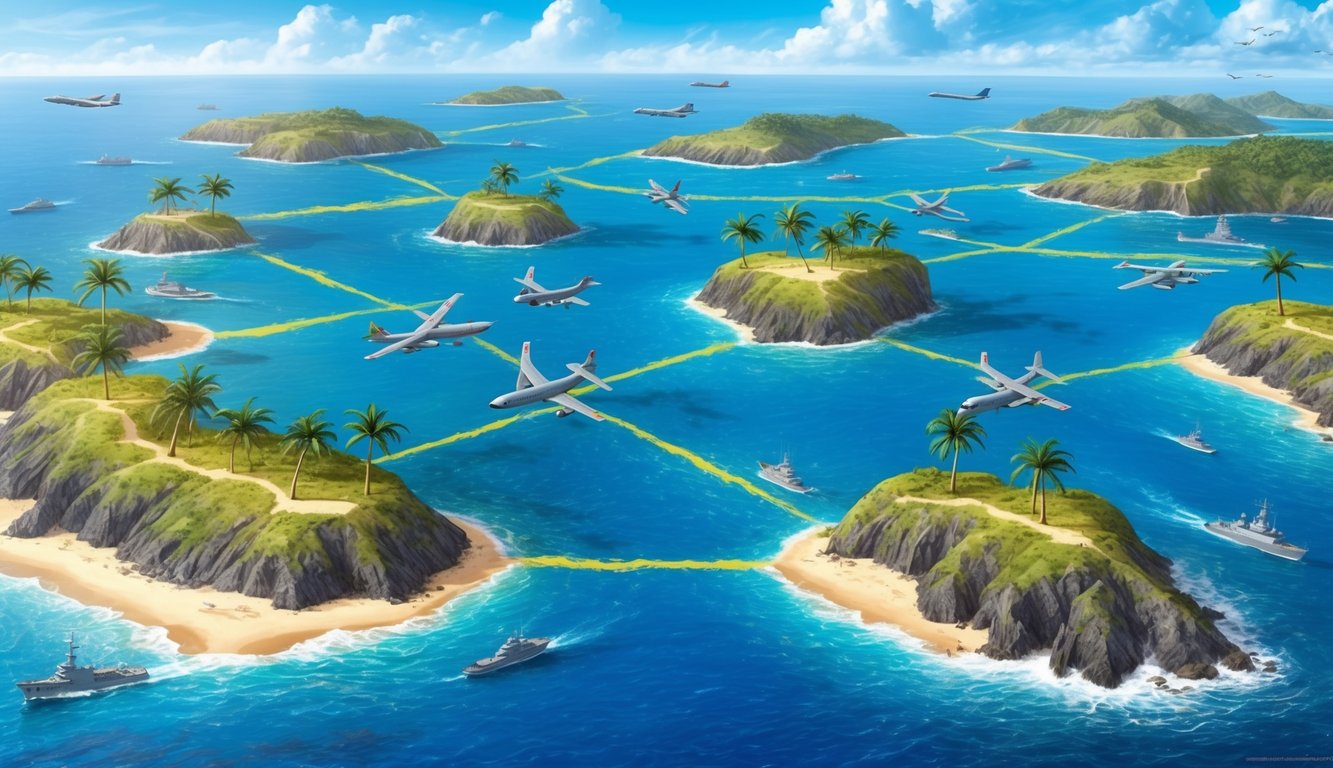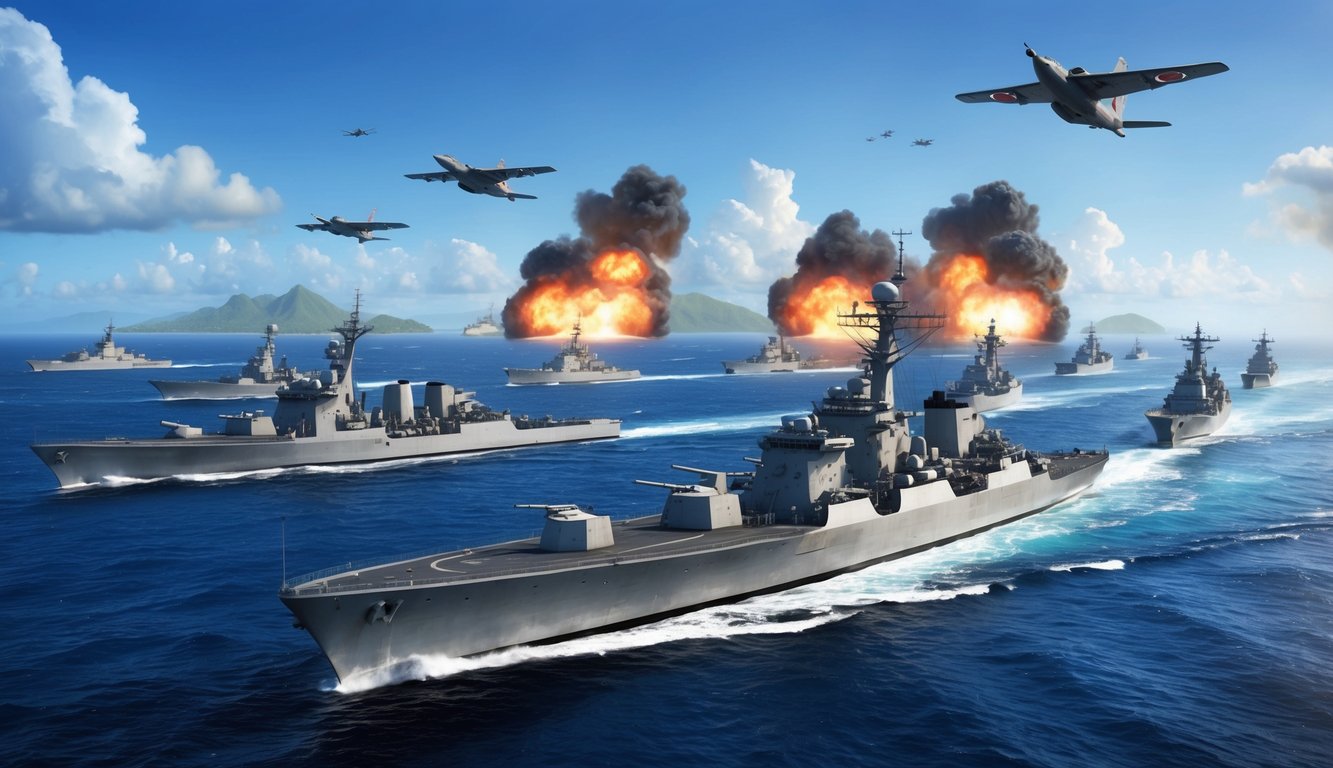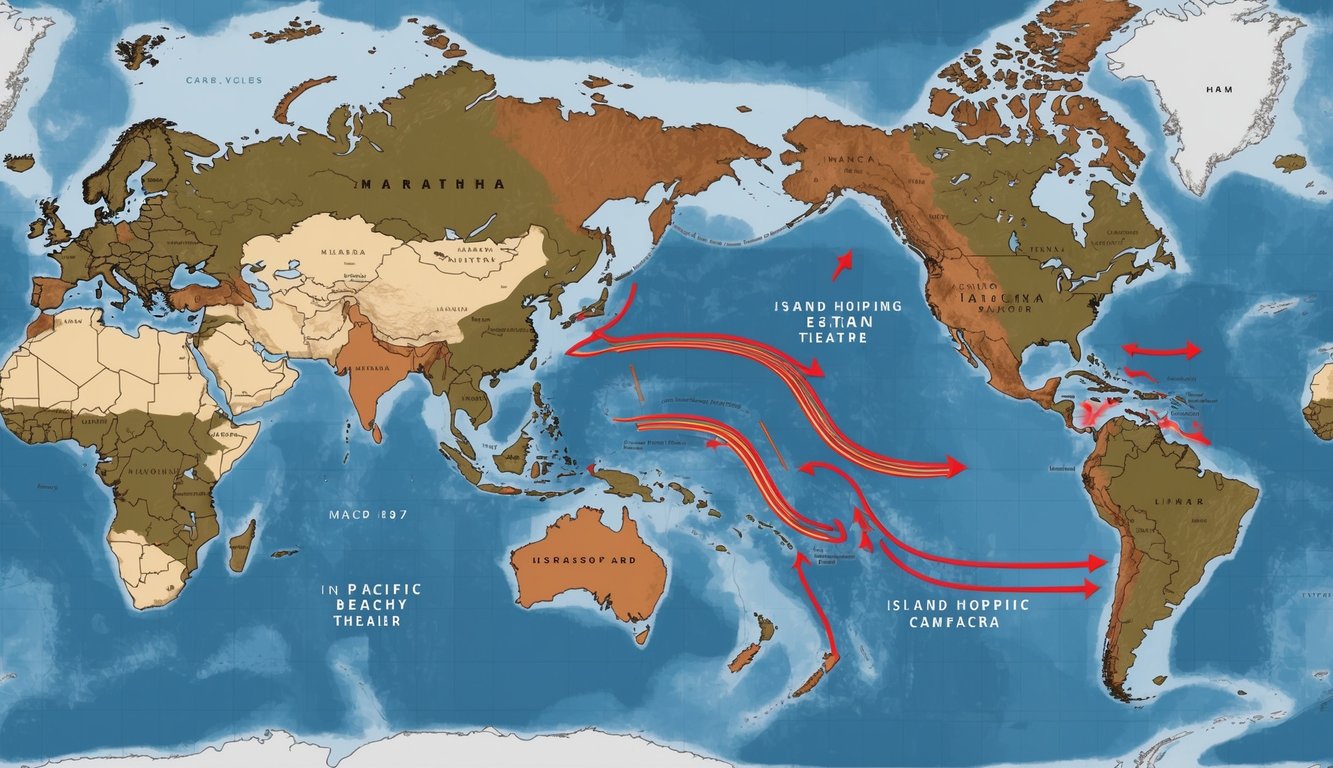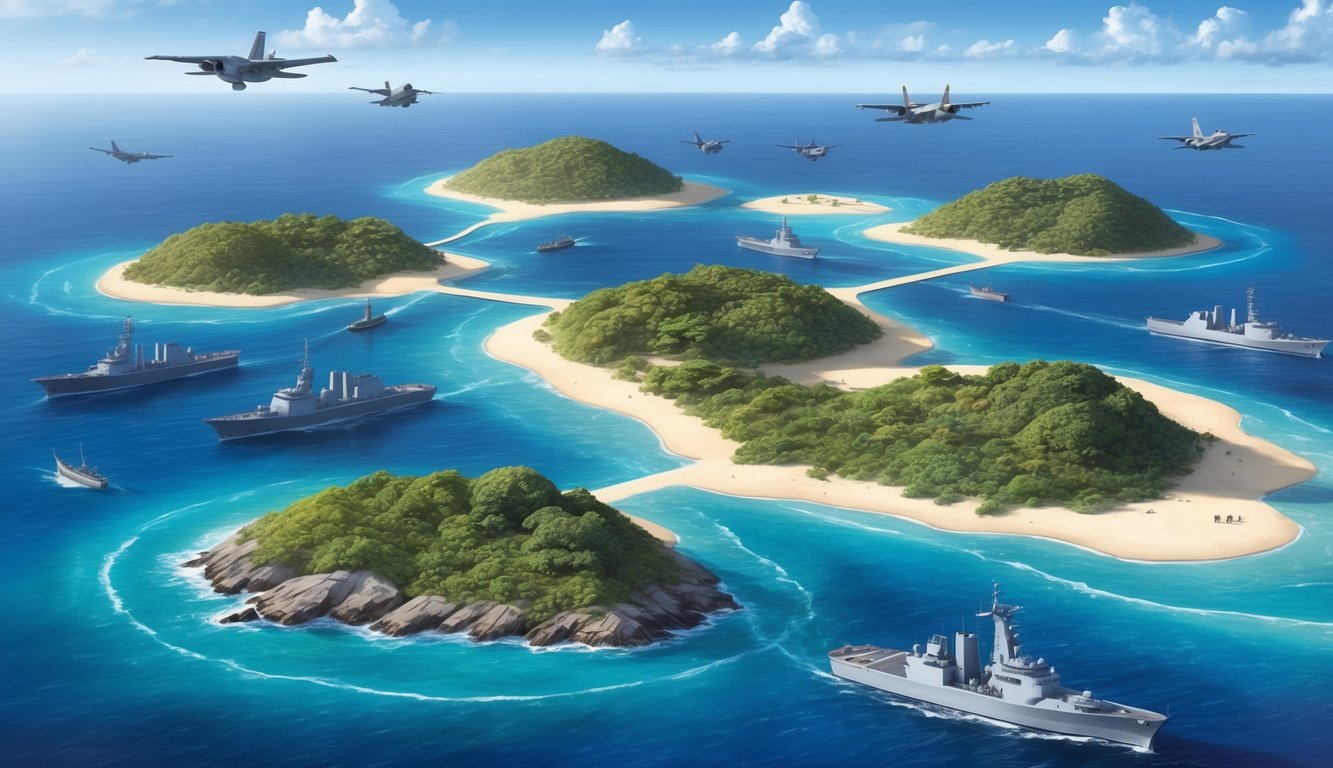The Pacific Theatre of World War II experienced some of the most intense battles across expansive ocean areas.
To counter Japanese territorial gains, Allied forces devised a strategy called “island hopping.” This method focused on seizing strategically significant islands while avoiding heavily defended Japanese positions, enabling the Allies to methodically advance towards Japan while preserving resources and minimizing troop casualties.
You may be curious about how this strategy was implemented.
Imagine a series of stepping stones leading across the Pacific, each one bringing Allied forces closer to their main objective.
From the Gilbert Islands to the Marshalls, and then onto the Marianas, American troops advanced by leapfrogging from one island to another.
Each captured island served as a base for air and naval operations, facilitating the next phase of the campaign.
The island hopping strategy was not solely about territorial gains; it also aimed to disrupt Japanese supply lines and isolate their forces.
By strategically selecting islands to capture, the Allies could establish air bases within striking range of Japan, while allowing bypassed enemy strongholds to weaken over time.
Key Takeaways
- Island hopping enabled Allied forces to strategically progress across the Pacific by avoiding heavily defended Japanese sites.
- Each conquered island acted as a stepping stone, providing bases for additional operations and drawing Allies closer to Japan.
- This strategy effectively isolated Japanese forces and disrupted their supply lines, diminishing the enemy’s capacity to resist.
The Concept of Island Hopping
Island hopping represented a pivotal Allied strategy in the Pacific Theater during World War II.
This involved securing strategically significant islands while avoiding heavily fortified Japanese locations.
Origins and Strategy
You might be curious about how the island hopping strategy emerged.
It was developed by Allied military leaders to prevent costly frontal assaults on well-defended Japanese positions.
Instead of attacking every island, the focus was on capturing strategically vital but lightly defended sites.
This strategy enabled the establishment of air and naval bases closer to Japan while disrupting enemy supply routes.
By leapfrogging between islands, Allied forces projected power across the vast expanse of the Pacific more efficiently.
The strategy also sought to isolate and neutralize bypassed Japanese positions without employing large forces to capture them.
Key Military Figures
Two significant figures in shaping the island hopping campaign were Admiral Chester Nimitz and General Douglas MacArthur.
Nimitz, as Commander-in-Chief of the Pacific Fleet, spearheaded the Central Pacific drive, managing successful operations in the Gilbert, Marshall, and Mariana Islands.
MacArthur, who led Allied forces in the Southwest Pacific, was at the forefront from New Guinea to the Philippines.
His renowned “I shall return” declaration illustrated his commitment to reclaiming the Philippines.
Despite differing strategic viewpoints, these leaders’ collaborative efforts brought the Allies closer to Japan.
Early Campaigns
The early campaigns in the Pacific Theatre laid the groundwork for the island hopping strategy that would come to define the conflict.
Events like Pearl Harbor, Midway, and Guadalcanal were pivotal in shaping the course of the war.
The Attack on Pearl Harbor
On December 7, 1941, Japanese forces executed a surprise attack on Pearl Harbor.
This devastating offensive severely crippled the U.S. Pacific Fleet, damaging or destroying 18 ships and more than 300 aircraft.
You might be surprised to learn that 2,403 Americans lost their lives that day.
The attack propelled the U.S. into World War II, and in its wake, Japanese forces quickly advanced throughout the Pacific, capturing Wake Island just two weeks later, despite fierce resistance from U.S. Marines and civilian contractors.
Battle of Midway
Only six months after Pearl Harbor, a pivotal shift occurred during the Battle of Midway in June 1942, where U.S. naval forces engaged the Japanese fleet near Midway Atoll.
American codebreakers had deciphered Japanese communications, providing the U.S. a critical advantage.
In a remarkable victory, U.S. dive bombers sank four Japanese aircraft carriers, inflicting significant damage to Japan’s naval capabilities from which it never fully recovered.
The implications of this battle shifted the momentum of the war favorably towards the Allies.
Guadalcanal Campaign
In August 1942, U.S. Marines landed on Guadalcanal in the Solomon Islands, marking the beginning of America’s first major offensive in the Pacific.
Gruesome jungle warfare and staunch Japanese resistance characterized this campaign, which lasted six months and involved significant losses on both sides.
U.S. forces fought across land, sea, and air to secure the island and its crucial airfield.
Guadalcanal functioned as a test for the island hopping strategy, demonstrating the ability to deny the enemy essential bases while moving towards the Japanese heartland.
Major Battles and Islands
The island hopping campaign in the Pacific encompassed crucial strategic battles across numerous island groups.
These confrontations were vital in repelling Japanese forces and ensuring Allied victory.
Liberation of the Philippines
The Philippines held immense strategic significance.
General MacArthur famously promised, “I shall return,” after being compelled to leave in 1942.
The offensive to reclaim the islands began in October 1944 with the landings at Leyte.
U.S. forces encountered fierce opposition but gradually secured control, culminating in the Battle of Leyte Gulf, one of the largest naval battles in history.
This battle effectively crippled Japan’s capacity to conduct offensive naval operations.
The campaign for Luzon, the largest island in the Philippines, commenced in January 1945, with the liberation of Manila occurring in March, albeit at a devastating cost to the city and its residents.
By August, most of the Philippines were back under Allied control.
Battle of Tarawa and the Gilbert Islands
The assault on Tarawa in November 1943 marked the first significant experience of brutal fighting in the Pacific.
This small coral atoll witnessed some of the bloodiest combat of the war.
U.S. Marines faced fortified Japanese defenses and a resolute enemy.
The three-day engagement resulted in over 1,000 American and 4,700 Japanese casualties.
Despite heavy losses, the capture of Tarawa yielded critical insights for future amphibious operations and secured an important airfield for forthcoming advances.
The Marshalls: Kwajalein and Eniwetok
The subsequent major objectives lay in the Marshall Islands.
U.S. forces captured Kwajalein, the globe’s largest coral atoll, in early February 1944 after just four days of fighting.
Eniwetok followed later that month.
The success of these operations provided control of vital airfields and ports, facilitating strikes against other Japanese-held islands and laying the groundwork for the push towards Japan itself.
The swift capture of these islands illustrated the increasing effectiveness of U.S. amphibious techniques.
The Mariana and Palau Islands Campaign
The Marianas campaign proved to be a turning point in the Pacific War.
The invasion of Saipan began in June 1944, leading to the Battle of the Philippine Sea, dubbed the “Marianas Turkey Shoot” due to the skewed aerial combat.
Tinian and Guam were secured next, providing bases for B-29 bombers capable of reaching the Japanese home islands.
The intense struggle for Peleliu in the Palau Islands began in September, lasting over two months and featuring some of the fiercest fighting of the conflict.
Iwo Jima and Okinawa
Iwo Jima, a small volcanic island, became the battleground for one of the war’s most notable confrontations.
U.S. Marines landed there in February 1945, facing tenacious Japanese resistance.
The island was declared secure after 36 days of intense conflict.
Okinawa, the largest and bloodiest operation in the Pacific, commenced in April 1945 and lasted nearly three months, resulting in substantial casualties on both sides.
Capturing this island provided a staging ground for the anticipated invasion of Japan.
These final confrontations highlighted the increasing desperation of Japanese forces and the heavy toll of victory as Allied troops approached the enemy homeland.
Military Tactics and Technology
The Pacific Theatre witnessed rapid innovations in military tactics and technological advancements.
Allied forces utilized naval strength, air dominance, and amphibious warfare to surmount Japanese defenses over vast stretches of ocean.
Naval Warfare
The U.S. Pacific Fleet played an integral role in the island-hopping campaign.
Massive fleets of battleships, destroyers, and cruisers projected power throughout the ocean.
Aircraft carriers became the cornerstone of naval strategy, launching powerful air assaults on Japanese positions.
Initially, the Imperial Japanese Navy held a strong position, but it struggled to replace losses.
As the war progressed, their carriers and battleships faced growing pressure.
Naval battles such as Midway and Leyte Gulf highlighted the shifting power dynamics in the Pacific.
Submarines also proved essential in disrupting Japanese supply routes and gathering intelligence.
New technologies like radar and enhanced torpedoes significantly boosted Allied forces’ naval combat capabilities.
Air Superiority and Technology
Air power transformed the landscape of warfare in the Pacific.
Swarms of fighters and bombers launched from carriers and land bases dominated the skies above island battlegrounds.
The introduction of long-range B-29 bombers allowed the U.S. to strike directly at Japanese territories, capable of carrying substantial bomb loads over long distances, placing pressure on Japan’s industrial capabilities.
Technological innovations improved aircraft performance and capacity.
Enhanced engines, armor, and weaponry provided Allied pilots an edge in aerial combat.
Advances in radar and communication enabled coordination of complex air operations over extensive distances.
Amphibious Landings and Ground Assault
Amphibious warfare became a defining characteristic of the island-hopping strategy.
Massive landing craft deployed troops and equipment onto heavily guarded beaches.
New vehicles like amphibious tractors helped Marines overcome challenging coral reefs and beach obstacles.
Improved landing craft designs facilitated quicker and more efficient troop deployment.
Close air support from carriers and land-based aircraft was crucial in softening Japanese defenses.
Ship-based artillery and mobile field guns provided essential fire support for advancing ground forces.
On the battlefield, U.S. forces adapted to the unique challenges of jungle and island warfare.
Flamethrowers, bazookas, and specialized weapons were employed to tackle fortified Japanese installations.
Throughout the campaign, tactics and equipment for engaging bunkers and cave complexes evolved significantly.
The Role of Allied Forces
Allied forces played an essential role in the Pacific island hopping operations.
Various nations contributed troops, resources, and strategic expertise crucial in pushing back Japanese forces across the expansive Pacific theatre.
Southeast Asia and the Pacific Allies
In Southeast Asia, a coalition comprising British, Indian, and American troops collaborated.
The British Pacific Fleet contributed significantly to the fight in 1944, enhancing naval strength in the region.
You might be surprised to know that Canadian forces also participated, primarily in intelligence and aircrew training capacities.
While the U.S. Marines led many amphibious assaults, they were supported by British and Dutch units in certain operations.
Coordination among these diverse forces was challenging, yet crucial for success.
Contributions from Australia and New Zealand
Australian and New Zealand forces were vital to the Allied campaign in the Pacific.
You’d find ANZAC troops engaged in numerous operations, from New Guinea to the Solomon Islands, with their regional knowledge proving invaluable.
Australian troops were integral to the New Guinea campaign, successfully repelling Japanese advances.
You might not realize that they also conducted commando raids and provided critical air support.
New Zealand’s navy patrolled vast segments of the Pacific, while its air force executed numerous missions.
Their ground forces displayed exceptional bravery in various island battles, exemplifying the same ANZAC spirit celebrated from World War I.
The Impact of Island Hopping

Island hopping had a profound effect on the trajectory of the Pacific War and on Japan’s defensive strategies.
This strategy compelled Japanese forces to adapt while facilitating the steady advancement of Allied forces throughout the Pacific.
On Japanese Defense and Strategy
Island hopping caused significant disruption to Japanese defensive operations.
Japanese commanders must have been frustrated as they watched Allied forces bypass well-fortified islands.
This strategy stretched Japan’s resources thin, as they attempted to protect numerous potential targets.
This approach made it increasingly difficult for Japan to concentrate its defensive efforts effectively.
The unpredictability of where the next attack might occur led to a reactive defense, weakening Japan’s overall strategy across the Pacific.
On the Course of the Pacific War
Island hopping significantly sped up the Allied advance throughout the Pacific.
By targeting critical islands, control over vital airfields and ports was achieved.
These captured locations served as launching points for further assaults, moving closer to Japan’s home islands.
This strategy also disrupted Japanese supply lines.
By leapfrogging from island to island, resources were cut off to the bypassed Japanese bases, leaving many enemy garrisons isolated and unable to support the broader war effort.
This tactic enabled better control over both the skies and seas.
Each island captured became a new base for air and naval operations, gradually shifting the balance of power in favor of the Allies.
Endgame in the Pacific

As Allied forces approached Japan, the concluding stages of the Pacific War transpired.
You can observe how crucial campaigns and decisive clashes ultimately led to the downfall of Imperial Japan.
The Philippines Campaign and Leyte Gulf
You might recall General Douglas MacArthur’s famous statement: “I shall return.” In October 1944, he fulfilled that promise as U.S. forces launched a significant assault on the Philippines, starting with Leyte.
This campaign represented a vital step in reclaiming the islands from Japanese control.
The ensuing Battle of Leyte Gulf soon became one of the most extensive naval engagements ever recorded.
You’d be astonished by its scale, including hundreds of ships clashing in a series of intense confrontations.
American forces delivered a devastating blow to the Japanese navy, severely crippling their capacity to defend their occupied territories.
Final Assaults and Japanese Surrender
As the war reached its conclusion, U.S. forces focused on Okinawa.
The Battle of Okinawa, spanning from April to June 1945, emerged as one of the bloodiest encounters in the Pacific Theater.
You’d be taken aback by the intensity of the combat and the high casualty rates on both sides.
With Okinawa secured, the Allies prepared for an invasion of Japan.
However, the atomic bombings of Hiroshima and Nagasaki in August 1945 altered the course of history.
Facing this devastating new weapon alongside a Soviet declaration of war in Manchuria, Japan ultimately surrendered on August 15, 1945.
Picture the relief felt by both soldiers and civilians as the lengthy and brutal Pacific War drew to a close.
The formal surrender ceremony occurred on September 2, 1945, aboard the USS Missouri in Tokyo Bay, marking the official end of World War II.
Frequently Asked Questions

The island-hopping campaign was a vital strategy in the Pacific Theatre during World War II.
Here are some frequently asked questions about this important military tactic.
What was the island-hopping campaign in the Pacific Theater?
Island-hopping was a military tactic utilized by Allied forces to progress across the Pacific Ocean towards Japan.
It involved capturing essential islands while bypassing well-fortified Japanese strongholds.
This method enabled the Allies to set up bases and airfields nearer to the Japanese mainland.
Who executed the strategy of island hopping during World War II?
The island-hopping strategy was chiefly enacted by U.S. forces led by General Douglas MacArthur and Admiral Chester Nimitz.
These commanders coordinated efforts across both the central and southwest Pacific to push back Japanese forces.
What was the strategic significance of the Allies’ island-hopping approach in the Pacific?
The primary aim of island hopping was to create a chain of Allied-controlled islands for launching air and naval assaults on Japan.
By skipping over heavily defended islands, Allied forces conserved resources and isolated Japanese positions, which allowed for a swifter advance towards the Japanese homeland.
Can you list the major battles in the Pacific Island campaigns in chronological order?
Key battles in the island-hopping campaign included:
- Guadalcanal (1942-1943)
- Tarawa (1943)
- Marshall Islands (1944)
- Saipan (1944)
- Guam (1944)
- Peleliu (1944)
- Philippines (1944-1945)
- Iwo Jima (1945)
- Okinawa (1945)
How did the island-hopping strategy contribute to the Allies’ victory in the Pacific during WWII?
The island-hopping strategy was fundamental to the success of the Allies in the Pacific.
It allowed U.S. forces to:
- Establish air and naval bases in closer proximity to Japan
- Cut off Japanese supply lines
- Weaken Japan’s defensive capabilities
- Secure strategic locations for launching attacks on the Japanese mainland
What was the outcome of the island-hopping campaign during WWII?
The island-hopping campaign effectively repelled Japanese forces across the Pacific.
It led to the capture of strategic islands and airfields, bringing Allied forces within the striking distance of Japan.
This strategy ultimately played a pivotal role in Japan’s surrender in August 1945, marking the end of World War II in the Pacific Theater.

